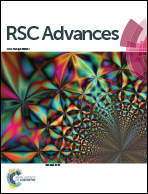NiMoO4@Ni(OH)2 core/shell nanorods supported on Ni foam for high-performance supercapacitors†
Abstract
Electrodes with rationally designed hybrid nanostructures can offer many opportunities for the enhanced performance in electrochemical energy storage. In this work, we demonstrate the design and fabrication of NiMoO4@Ni(OH)2 core/shell nanorods on nickel foam via a facile hydrothermal and electrodeposition process for supercapacitor applications. The novel nanoscale morphology has been proven to be responsible for their excellent capacitive performances. Ni(OH)2 nanosheets were uniformly wrapped on the surface of each NiMoO4 nanowire, which increased the capacitance of NiMoO4@Ni(OH)2 core/shell nanorods to a high areal capacitance of 7.43 F cm−2 at 4 mA cm−2. 72% of the initial capacity was retained after 1000 cycles at a current density of 8 mA cm−2. These results indicate that the NiMoO4@Ni(OH)2 core/shell nanorods could be a promising electrode material for high-performance electrochemical capacitors.


 Please wait while we load your content...
Please wait while we load your content...